Haementeria ghilianii
Sangsue géante d'Amazonie
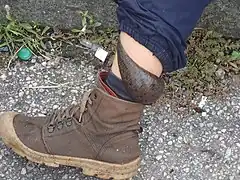
| Règne | Animalia |
|---|---|
| Embranchement | Annelida |
| Classe | Clitellata |
| Sous-classe | Hirudinea |
| Infra-classe | Euhirudinea |
| Ordre | Rhynchobdellida |
| Sous-ordre | Glossiphoniiformes |
| Famille | Glossiphoniidae |
| Sous-famille | Haementeriinae |
| Genre | Haementeria |
Haementeria ghilianii, la sangsue géante d'Amazonie, est l'une des plus grandes espèces de sangsues au monde[3]. Elle peut atteindre 45 cm de longueur et 10 cm de largeur. À l'âge adulte, cette sangsue est de couleur brun grisâtre, contrairement aux juvéniles qui n'ont pas une couleur uniforme, mais plutôt une bande de couleur discontinue. On la trouve dans les marais depuis les Guyanes jusqu'à l'Amazonie[4]. Dans ses glandes salivaires, cette sangsue produit de l'hémentine, une protéase anticoagulante.
Elle n'avait plus été observée par les scientifiques depuis les années 1890 jusqu'à ce que des chercheurs américains (Dr Roy Sawyer) redécouvrent des spécimens en Guyane dans les années 1970[5]. L'une de ces sangsues, surnommée « Grandma Moses », est à l'origine d'un élevage prospère à l'université de Californie à Berkeley (UC Berkeley)[6]. Ainsi, la sangsue « Grandma Moses » capturée à Sinnamary dans les années 1970 a fini sa vie dans les laboratoires de l'université, où elle donna naissance à 750 petits en trois ans (d'un prix estimé à 150 $ chacun). De nouvelles campagnes de capture eurent lieu au début des années 2000[7]. Elle est à l'origine de plus d'une cinquantaine de publications scientifiques parmi lesquelles la caractérisation et la purification de plusieurs protéines avec des effets antimétastatiques, et anticoagulants, l'hémentine qui détruit la fibrine humaine dans les caillots de sang, la cartographie du raccordement des cellules nerveuses, et la morphologie fonctionnelle des cellules nerveuses et salivaires.
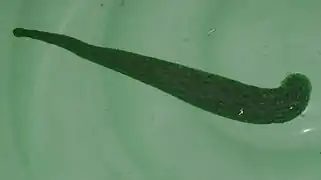 Individu à jeun.
Individu à jeun.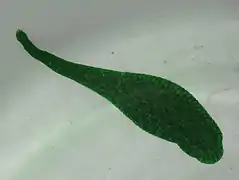 Individu à jeun.
Individu à jeun.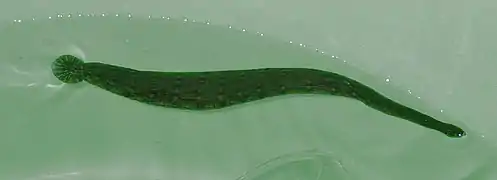 Nage.
Nage.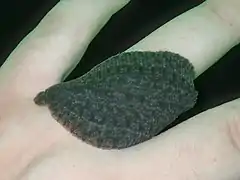 Début de repas.
Début de repas.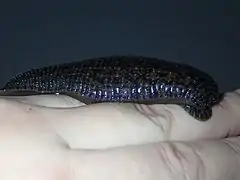 Repas.
Repas.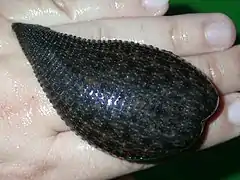 Repas.
Repas..jpg.webp) Repas.
Repas..jpg.webp) Fin de repas.
Fin de repas.
Notes et références
- (de) F. de Filippi, « Über eine neue riesengrosse Egelart », Z. Wiss. Zool., vol. 1, , p. 256-257
- (it) F. de Filippi, « Sopra un nuovo genre (Haementeria) di Annelidi della famiglia della Sanguisughe », Mem. Acc. Sci. Torino, vol. 10, no 2, , p. 1-14
- (en) « Invertebrate Zoology / Smithsonian National Museum of Natural History », sur si.edu (consulté le ).
- (en) « Leeches : Hirudinea - Giant Amazonian Leech (haementeria Ghilianii) : Species Accounts », sur jrank.org (consulté le ).
- (en) Megan Gambino, « The List: 5 Weirdest Worms at the Smithsonian : Cheryl Bright, manager of the Smithsonian’s National Invertebrate Collection, leads a “show and tell” of her favorite creepy crawlers », smithsonianmag.com, (lire en ligne) :
« 1. Giant Amazon Leech – Haementeria ghilianii, or the giant Amazon leech, can certainly grow to giant proportions. At up to 18 inches long, it is the largest leech in the world. The species was thought to be extinct, from the 1890s until the 1970s, when two adults were collected in French Guiana. One ended up at the University of California-Berkeley. Grandma Moses, as she was named, produced more than 750 baby leeches in just three years. Scientists in the fields of medicine, neurology and natural history studied Grandma Moses’s breeding colony and published a total of 46 pieces of research. When the leech died, UC Berkeley decided that the National Worm Collection was a suitable resting place for her. In Bright’s hand, Grandma Moses was the shape of a cobra’s hood, wide in the center but tapered on either end. »
- Steven Ryan, « Amazon Giant Leech (Haementeria ghilianii) », University of Northern British Columbia blogs, (consulté le )
- Mark E. Siddall et Susan L. Perkins, « Search for the Giant Amazon Leech : Examining the coevolution of blood feeding leeches and their bacterial endosymbionts », French Guyana, The National Science Foundation, The Niarchos Foundation, The Lewis and Dorothy Cullman Program in Molecular Systematic Studies, The Ambrose Monell Foundation, december 28, 2001 - january 8, 2002.
Voir aussi
Références taxonomiques
- (en) Référence Animal Diversity Web : ghilianii/ Haementeria ghilianii
- (en) Référence NCBI : Haementeria ghilianii (taxons inclus)
1980-1984
- (en) E. R. Macagno, « Number and distribution of neurons in leech segmental ganglia », Journal of Comparative Neurology, vol. 190, no 2, , p. 283-302
- (en) Andrei Z. Budzynski, Stephanie A. Olexa et Barbara S. Brizuela, « Anticoagulant and Fibrinolytic Properties of Salivary Proteins from the Leech Haementeria ghilianii », SAGE journal, vol. 168, no 2, (ISSN 0037-9727, DOI 10.3181/00379727-168-41271, lire en ligne)
- (en) Andrei Z. Budzynski, Stephanie A. Olexa et Roy T. Sawyer, « Composition of Salivary Gland Extracts from the Leech Haementeria ghilianii », SAGE journals, vol. 168, no 2, (ISSN 0037-9727, DOI 10.3181/00379727-168-41270, lire en ligne)
- (en) Andrew P. Kramer et John R. Goldman, « The nervous system of the Glossiphoniid leech Haementeria ghilianii : I. Identification of neurons », Journal of comparative physiology, vol. 144, , p. 435–448 (lire en ligne)
- (en) KRAMER AP, « The nervous system of the Glossiphoniid leech Haementeria ghilianii : II: SYNAPTIC PATHWAYS CONTROLLING BODY WALL SHORTENING », J. COMP. PHYSIOL., A, UNIV. CALIFORNIA, DEP. MOLECULAR BIOL./BERKELEY CA 94720/USA, vol. 144, no 4, , p. 449-457 (ISSN 0340-7594)
- (en) ROY T. SAWYER, FRANCOIS LEPONT, DUNCAN K. STUART, et ANDREW P. KRAMER, « Growth and reproduction of the giant Glossiphoniid leech Haementeria ghilianii », The Biological Bulletin, vol. 160, no 2, (lire en ligne)
- (en) SAWYER R. T., « Anticoagulant and fibrinolytic properties of the salivary gland proteins from the Leech Haementeria Ghilianii », Thromb Haemostasis, vol. 46, , p. 64
- (en) SAWYER RT, DAMAS D et TOMIC MT, « ANATOMY AND HISTOCHEMISTRY OF THE SALIVARY COMPLEX OF THE GIANT LEECH HAEMENTERIA GHILIANII (HIRUDINEA: RHYNCHOBDELLIDA) », ARCHIVES DE ZOOLOGIE EXPERIMENTALE ET GENERALE, vol. 122, no 4, , p. 411-425 (ISSN 0003-9667)
- (en) Hollis T. Cline, « 3H‐GABA uptake selectively labels identifiable neurons in the leech central nervous system », The Journal of Comparative Neurology, vol. 215, no 3, , p. 351-358 (DOI 10.1002/cne.902150309, lire en ligne)
- (en) Gabriel J. Gasic, Edward D. Viner, Andrei Z. Budzynski et Gregory P. Gasic, « Inhibition of Lung Tumor Colonization by Leech Salivary Gland Extracts from Haementeria ghilianii », Cancer Research, vol. 43, no 4, , p. 1633-1636 (ISSN 0008-5472, lire en ligne)
- (en) Sawyer R. T., Stent G. S., Budzynski A. Z. et Olexa S. A., « Hementin--a fibrinolytic agent », U.S. Patent, Washington, DC: U.S. Patent and Trademark Office., nos 4,390,630, (lire en ligne)
- (en) Scott M. Malinconico, Jessica B. Katz et Andrei Z. Budzynski, « Hementin: anticoagulant protease from the salivary gland of the leech Haementeria ghilianii », Translational Research, vol. 103, no 1, , p. 44-58 (DOI 10.5555/uri:pii:0022214384901537, lire en ligne)
- (en) Scott M. Malinconico, Jessica B. Katz et Andrei Z. Budzynski, « Fibrinogen degradation by hementin, a fibrinogenolytic anticoagulant from the salivary glands of the leech Haementeria ghilianii », Translational Research, vol. 104, no 5, , P842-854 (DOI 10.5555/uri:pii:0022214384902750, lire en ligne)
- (en) E H Murer, H L James, A Z Budzynski, S M Malinconico et G J Gasic, « Protease Inhibitors in Haementeria Leech Species », Thromb Haemost, vol. 51, no 01, , p. 024-026 (DOI 10.1055/s-0038-1661011, lire en ligne)
1985-1989
- (en) AP Kramer, JR Goldman et GS Stent, « Developmental arborization of sensory neurons in the leech Haementeria ghilianii : I. Origin of natural variations in the branching pattern », Journal of Neuroscience, vol. 5, no 3, , p. 759-767 (DOI 10.1523/JNEUROSCI.05-03-00759.1985, lire en ligne)
- (en) AP Kramer et GS Stent, « Developmental arborization of sensory neurons in the leech Haementeria ghilianii : II. Experimentally induced variations in the branching pattern », Journal of Neuroscience, vol. 5, no 3, , p. 768-775 (ISSN 0270-6474, DOI 10.1523/JNEUROSCI.05-03-00768.1985, lire en ligne)
- (en) HT Cline, « Evidence for GABA as a neurotransmitter in the leech », Journal of Neuroscience, vol. 6, no 10, , p. 2848-2856 (ISSN 1529-2401, DOI 10.1523/JNEUROSCI.06-10-02848.1986, lire en ligne)
- (en) Curtis M. Loer, Carol Schley, Birgit Zipser et William B. Kristan Jr., « Development of segmental differences in the pressure mechanosensory neurons of the leech haementeria ghilianii », Journal of Comparative Neurology, vol. 254, no 3, , p. 403-409 (DOI 10.1002/cne.902540311, lire en ligne)
- (en) Joel C. Glover, « Serotonin storage and uptake by identified neurons in the leech Haementeria ghilianii », the journal of comparative neurology, vol. 256, no 1, , p. 117-127 (DOI 10.1002/cne.902560110, lire en ligne)
- (en) JC Glover, DK Stuart, HT Cline, RE McCaman, C Magill et GS Stent, « Development of neurotransmitter metabolism in embryos of the leech Haementeria ghilianii », Journal of Neuroscience, vol. 7, no 2, , p. 581-594 (ISSN 1529-2401, DOI 10.1523/JNEUROSCI.07-02-00581.1987, lire en ligne)
- (en) Bernd Walz, Karl‐Heinz Schäffner et Roy T. Sawyer, « Ultrastructure of the anterior salivary gland cells of the giant leech, Haementeria ghilianii (Annelida, Hirudinea) », journal of morphology, vol. 196, no 3, , p. 321-332 (DOI 10.1002/jmor.1051960305, lire en ligne)
- (en) WERNER A. WUTTKE et MICHAEL S. BERRY, « Calcium-Dependent Action Potentials in Giant Salivary Gland Cells of the Leech: Haementeria Ghilianii: Calcium Removal Induces Dependence on Sodium », Journal of Experimental Biology, vol. 138, nos 431-453, (lire en ligne)
- (en) Alan D. Cardin, « Extraction and purification of an anticoagulant principle from the south american leech, haementeria ghilianii », United States Patent, vol. US4832849, 05/23/1989 (lire en ligne)
- (en) Cindra Condra, Elka Nutt, Christopher J. Petroski, E. Simpson, P. A. Friedman et J. W. Jacobs, « Isolation and Structural Charaderization of a Potent Inhibitor of Coagulation Factor Xa from the Leech Haementeria ghilianii », Thrombosis and haemostasis, vol. 62(03), , p. 437-441 (DOI 10.1055/s-0038-1646610, lire en ligne)
- (en) WERNER A. WUTTKE, ROY T. SAWYER et MICHAEL S. BERRY, « EXTRAGLANDULAR INNERVATION OF THE SALIVARY CELLS OF THE LEECH HAEMENTERIA GHILIANII: NEURONAL STIMULATION ELICITS GLAND-CELL ACTION POTENTIALS AND SECRETION », Journal of Experimental Biology, vol. 143, , p. 389-410 (lire en ligne)
1990-1994
- (en) Dale T. Blankenship, Robert G. Brankamp, George D. Manley et Alan D. Cardin, « Amino acid sequence of ghilanten: Anticoagulant-antimetastatic principle of the south American leech, Haementeria ghilianii », Biochemical and Biophysical Research Communications, vol. 166, no 3, , p. 1384-1389 (DOI 10.1016/0006-291X(90)91020-S, lire en ligne)
- (en) Brankamp RG, Blankenship DT, Sunkara PS et Cardin AD, « Ghilantens: anticoagulant-antimetastatic proteins from the South American leech, Haementeria ghilianii », The Journal of Laboratory and Clinical Medicine, vol. 115, no 1, , p. 89-97 (lire en ligne)
- (en) KIRSCHBAUM N.E., THE CONSEQUENCES OF CLEAVING FIBRINOGEN WITH THE ANTICOAGULANT PROTEASE, HEMENTIN, FROM THE LEECH, HAEMENTERIA GHILIANII, Andrei Z. Budzynski,
- (en) Joel K. Swadesh, I.-Yih Huang et Andrei Z. Budzynski, « Purification and characterization of hementin, a fibrinogenolytic protease from the leech Haementeria ghilianii », Journal of Chromatography A, vol. 502, , p. 359-369 (DOI 10.1016/S0021-9673(01)89600-X, lire en ligne)
- (en) W A Wuttke et M S Berry, « Rapid co‐transport of sodium and chloride ions in giant salivary gland cells of the leech Haementeria ghilianii », The Journal of physiology, vol. 427, no 1, , p. 51-69 (DOI 10.1113/jphysiol.1990.sp018160, lire en ligne)
- (en) Brankamp RG, Manley GG, Blankenship DT, Bowlin TL et Cardin AD, « Studies on the anticoagulant, antimetastatic and heparin-binding properties of ghilanten-related inhibitors. », Blood Coagulation & Fibrinolysis : an International Journal in Haemostasis and Thrombosis, vol. 2, no 1, , p. 161-166 (PMID 1772984, DOI 10.1097/00001721-199102000-00024, lire en ligne)
- (en) Budzynski AZ, « Interaction of hementin with fibrinogen and fibrin », Blood Coagulation & Fibrinolysis : an International Journal in Haemostasis and Thrombosis, vol. 2, no 1, , p. 149-152 (PMID 1772982, DOI 10.1097/00001721-199102000-00022, lire en ligne)
- (en) R. T. Sawyer, C. Powell Jones et R. Munro, « The biological function of Hementin in the Proboscis of the leech Haementeria ghilianii », Blood Coagulation and Fibrinolysis, vol. 2, , p. 153-159 (lire en ligne)
- (en) R. T. Sawyer, M. Casellas, R. Munro et C. Powell Jones, « Secretion of hementin and other antihaemostatic factors in the salivary gland complex of the giant amazon leech Haementeria ghilianii », Comparative Haematology International, vol. 1, , p. 35–41 (DOI 10.1007/BF00422691, lire en ligne)
- (en) WERNER A. WUTTKE et MICHAEL S. BERRY, « Initiation and Modulation Of Action Potentials in Salivary Gland Cells of Haementer1A Ghilianii by Putative Transmitters and Cyclic Nucleotides », Journal of Experimental Biology, vol. 157, , p. 101-122 (lire en ligne)
- (en) C. M. Bishop, « Learning from a sucker », Occupational Medicine, vol. 42, no 1, , p. 53-54 (DOI 10.1093/occmed/42.1.53, lire en ligne)
- (en) WA Wuttke et MS Berry, « Extracellular ATP selectively modulates a high-voltage-activated calcium conductance in salivary gland cells of the leech Haementeria ghilianii », Journal of Experimental Biology, vol. 181, , p. 313-319 (lire en ligne)
- (en) MARKWARDT, F, « Coagulation inhibitors from blood-sucking animals : a new line of developing antithrombotic drugs », Pharmazie, vol. 49, no 5, , p. 313-316 (ISSN 0031-7144)
- (en) W A Wuttke, T Munsch et M S Berry, « Intracellular pH of giant salivary gland cells of the leech Haementeria ghilianii: regulation and effects on secretion. », Journal of Experimental Biology, vol. 189, , p. 179-198 (lire en ligne)
1995-1999
- (en) Alan D. CARDIN et Sai P. SUNKARA, « Ghilanten antimetastatic principle from the south american leech, Haementeria ghilianii », U.S. Patent, Washington, DC: U.S. Patent and Trademark Office., nos 5,447,911, (lire en ligne)
- (en) Finney, S., Seale, L., Sawyer, R. T. et Wallis, R. B., « Tridegin, a new factor XIIIa inhibitor from the Giant Amazon Leech, Haementeria ghilianii », Blood Coagulation & Fibrinolysis, vol. 7, no 7, , p. 730
- (en) W Wuttke, T Munsch et J Deitmer, « Inhibition of voltage-dependent Ca2+influx by extracellular ATP in salivary cells of the leech Haementeria ghilianii », Journal of Experimental Biology, vol. 199, , p. 1335-1341 (lire en ligne)
- (en) Sarah FINNEY, Lisa SEALE, Roy T. SAWYER et Robert B. WALLIS, « Tridegin, a new peptidic inhibitor of factor XIIIa, from the blood-sucking leech Haementeria ghilianii », Biochemical journal, vol. 324, no 3, , p. 797–805 (ISSN 0264-6021, DOI 10.1042/bj3240797, lire en ligne)
- (en) Lisa Seale, Sarah Finney, Roy T Sawyer et Robert B Wallis, « Tridegin, a Novel Peptidic Inhibitor of Factor XIIIa from the Leech, Haementeria ghilianii, Enhances Fibrinolysis In Vitro », Thromb Haemost, vol. 77, no 05, , p. 0959-0963 (DOI 10.1055/s-0038-1656085, lire en ligne)
- (en) Wallis RB, Seale L, Finney S, Sawyer RT, Bennett GM et Ross-Murphy SB, « Reduction of plasma clot stability by a novel factor XIIIa inhibitor from the Giant Amazon Leech, Haementeria ghilianii. », Blood Coagulation & Fibrinolysis : an International Journal in Haemostasis and Thrombosis, vol. 8, no 5, , p. 291-295 (PMID 9282793, DOI 10.1097/00001721-199707000-00005, lire en ligne)
- (en) Ana Marisa Chudzinski-Tavassi, Eva Maria A. Kelen, Ana Paula de Paula Rosa, Stephane Loyau, Claudio A. M. Sampaio, Cassian Bon et Eduardo Anglés-Cano, « Fibrino(geno)lytic Properties of Purified Hementerin, a Metalloproteinase from the Leech Haementeria depressa », Thrombosis and Haemostasis, vol. 80, no 01, , p. 155-160 (DOI 10.1055/s-0037-1615155, lire en ligne)
- (en) Fernanda Faria, Eva Maria A. Kelen, Claudio A. M. Sampaio, Cassian Bon, Nathalie Duval et Ana Marisa Chudzinski-Tavassi, « A New Factor Xa Inhibitor (Lefaxin) from the Haementeria depressa Leech », Thromb Haemost, vol. 82, no 05, , p. 1469-1473 (DOI 10.1055/s-0037-1614857, lire en ligne)
2000-2004
- (en) Robert M. Scarborough, Bing-yan Zhu et Ting Su, « Selective factor Xa inhibitors », United States Patent 6204268, 03/20/2001 (lire en ligne)
- (en) U. Rester, W. Bode, C. A. M. Sampaio, E. Auerswald et A. P. Y. Lopes, « Cloning, purification, crystallization and preliminary X-ray diffraction analysis of the antistasin-type inhibitor ghilanten (domain I) from Haementeria ghilianii in complex with porcine [beta]-trypsin », Acta Cryst., vol. D57, , p. 1038-1041 (DOI 10.1107/S0907444901007272, lire en ligne)
2005-2009
- (en) Susan L. Perkins, Rebecca B. Budinoff et Mark E. Siddall, « New Gammaproteobacteria Associated with Blood-Feeding Leeches and a Broad Phylogenetic Analysis of Leech Endosymbionts », Applied and Environmental Microbiology, (ISSN 1098-5336, DOI 10.1128/AEM.71.9.5219-5224.2005, lire en ligne)
2010...
- (en) Alejandro Oceguera-Figueroa, « Molecular phylogeny of the New World bloodfeeding leeches of the genus Haementeria and reconsideration of the biannulate genus Oligobdella », Molecular Phylogenetics and Evolution, vol. 62, no 1, , p. 508-514 (DOI 10.1016/j.ympev.2011.10.020, lire en ligne)